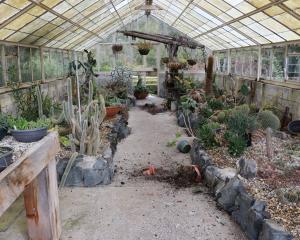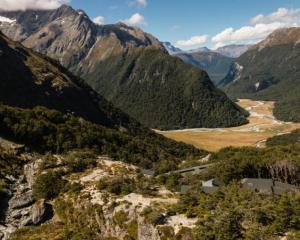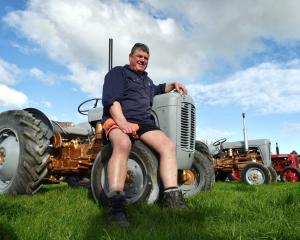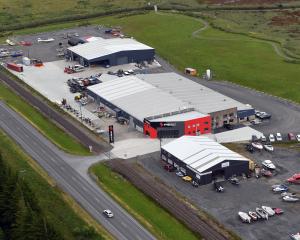Moves are afoot to make the small Otago township of Beaumont the thriving community it once was. John Gibb finds out about Beaumont's changing fortunes.
Once a fading rural backwater, the township of Beaumont now seems destined for a much brighter future.
People who have lived near the inland Otago township, on the Clutha River/Mata-au, for 20 years or more will remember earlier sometimes divisive and frustrating conflicts over proposed big hydro-electric dams, which would have flooded the area.
One proposal, by the Electricity Corporation of New Zealand (ECNZ) in 1992, was to build a dam at Tuapeka Mouth that would have flooded 3000ha, including all of Beaumont. But among a series of more promising developments the long-delayed replacement work involving the nearby 19th century Beaumont Bridge is at last due to start next year.
This is one of the oldest bridges in the country still operating on a major state highway.
And more walkers and cyclists are already starting to move through the township since the 73km-long Clutha Gold Trail- which runs between Roxburgh and Lawrence, and includes Beaumont- was opened by Prime Minister John Key on October 24. Long-time resident, historian and writer Bill Dacker (61) is well aware of the area's previously somewhat mixed fortunes.
''It was a little backwater that we enjoyed as a backwater,'' he recalls.
But then a series of dam proposals came along and changed everything, he said.
Some locals, including some facing tough economic times, had agreed to sell their land.
Others, including the ''Hands Off Beaumont'' lobbyists, were determined to resist and to safeguard all they found precious in the area, including its rich history and its attractive and distinctive environment.
Mr Dacker highlights the significance of the bridge replacement work.
The current bridge had been around since 1887 and had struggled to cope with some of the ''huge trucks'' now passing through.
Mr Dacker, who is a long-standing member of the Clutha Gold Trail Trust Board, says the newly opened trail and other developments mean brighter times are coming for Beaumont, which will boost the local economy by bringing in more visitors and potential new residents. Strengthening Beaumont was also important strategically, because it gave the area a better chance of influencing its own destiny in future, he said.
''Unless we're going to make the place strong in a different way, other people are [still] going to see it as a backwater,'' he says.
Dave Crawford is an experienced jet boater and co-owner-operator of Beaumont Jet, with his wife Ali, And he is also a Gold Trail board member.
It was ''great'' to see the cyclists already starting to flow along the track, through Beaumont.
''It can only be good for this area,'' he says.
When he and his wife moved to Beaumont and began jet boat operations in 2004, he had long known the area had strong potential.
The nearby Clutha River/Mata-au is ''probably the best part of the Clutha River'', he adds.
These stretches of the river were also as good as ''anything in New Zealand'' and offered plenty of variety, including ''huge rapids'' and other ecologically appealing areas.
And he is not content with Beaumont being one of the region's and New Zealand's best-kept secrets.
''The more people the better.''
Mr Dacker, who these days divides his time between Beaumont and Port Chalmers, has lived in Beaumont for much of his life, having grown up there.
His father, Harry Dacker, had initially found work there as a rabbiter in the 1920s.
Bill Dacker said the idea of building a''cycle-cum-walking trail through the district, along the river and through the farmland to Lawrence, was a direct response - a way of creating economic opportunity by bringing people into this area as well as the other areas connected by the trail''.
The idea had come from the trust's Roxburgh-based chairman, Rod Peirce, who was a ''retired orchardist from Millers Flat with long-standing connections in Beaumont as well as to the other communities along the trail.''
The lessees of the Beaumont Hotel had also contributed to the upturn in Beaumont's fortunes by continuing to develop and support ''events tailored to hunters and fishermen while adding cyclists to those they wish to give hospitality to''.
And the pub also served ''the best blue cod meals this side of Iceland'', Mr Dacker said.
Widespread support from the Beaumont community for the trust, as well as backing from ''other communities connected by the trail'', had been key to the success of the trail development.
This sense of unity and support stood in ''stark contrast to divisions in the communities'' sparked by the ECNZ dam proposal in 1992, and was ''a wonderful thing to experience''.
Alison Mills, who leases the hotel with her husband, Gunni Egilsson, is also optimistic about the future, and says patrons with different interests and from range of backgrounds, including tourists, were using the hotel and nearby camping ground.
Mr Dacker noted there had been some ''recent controversy'' over suggestions of fees for using the trail.
He emphasised there was no official fee for using it, ''but the trust asks for a koha [donation], a contribution for its maintenance from its users as at the moment the trust is solely responsible for costs of its maintenance''.
Mr Peirce (76) said there were early signs that the new trail would prove positive, and help revive smaller communities such as Beaumont and Millers Flat.
''It's very satisfying. There's a general air of enthusiasm.''
Mr Peirce, who was also once chairman of the Friends of Beaumont group, had opposed various proposals to establish big new dams nearby.
And he is positive about the new trail's benefits.
''I thought, if there's any legacy I can leave, it may well be more like the trail, which is more positive, rather than being an activist against everything.
''I'd like to be seen as someone who left something for the benefit of the community.''
People were already starting to come from far afield to ride or walk the new trail, and local families were also enjoying it.
''We've had a tremendous amount of support from Contact Energy.''
And $3.8 million from the Government's New Zealand Cycle Trail project funding had been used to support the trail's development. Through the years Mr Peirce has noticed rural decline, including loss of population and services, in some of the smaller communities.
''It's very positive. I think that the smaller villages will definitely gain a tremendous amount over the next several years and into the future from the trail.''
And Beaumont was already looking up. The school had closed some decades ago, but ''rural visitors'' were increasing and the pub was humming - ''it's quite a busy little pub'', Mr Peirce said.
The gold trail was also good for Millers Flat - ''it's the only town that the trail actually goes right through the middle of.''
And Mr Dacker highlights Beaumont's distinctive geographical position, and its historical significance.
Beaumont is the first crossing place of the Clutha River/Mata-au when travelling on SH8 from Milton to Central Otago, and its many attractions. And the area was ''one of the major entrance and exit points'' for the Clutha Gold Trail walkway.
The Clutha River/Mata-au is one of the outstanding natural features of the newly opened trail, which follows the river ''on its journey across the river flats below Roxburgh, through the Beaumont Gorge, before it turns toward Lawrence at Beaumont'', Mr Dacker says. The river crosses the Beaumont Flat and then passes through the Rongahere Gorge, the ''last major river flat and gorge respectively of the schist peneplain or block mountain system of the Central Otago highlands''.
Beaumont was a true border between very different geographical zones.
''On the Rongahere side the climate is wetter and cooler, more like that of coastal Otago than Central Otago.
''On the Beaumont Gorge side the climate is hotter and drier, marking the beginning of Central Otago proper.''
The Maori name for the district is Te Kohai and here the ancestors of Kai Tahu Whanui also crossed the river, but on mokihi (traditional rafts), on their journeys into the interior.
There was also once a moa-hunting era village at Beaumont.
The town of Beaumont grew around the river crossing, where a ferry operated, accompanied by a supporting structure of hotels and shops. The natural vegetation of the nearby gorges reflected the ''borderland'' characteristics.
The dominant tree on Upper Birch Island - also known locally as Native Island - in the Beaumont Gorge is mountain beech, indicating the drier and hotter conditions there. The far larger Birch Island, or Moanui, in the Rongahere Gorge below Beaumont, and the bush of the gorge itself, has a covering of a mixed podocarp forest that includes sphagnum moss, mountain and silver beech as well as totara and matai.
''Both the gorge and the island are home to rare and nearly extinct insect species, protected on the island from rat predation by the swift waters of the river,'' Mr Dacker says.
''Beaumont's fortunes have fluctuated over the years according to major changes in the economic, gold-mining and agricultural history of the province.''
First the search for gold, then the arrival of the railways and the rise of horticulture on the river flats of Central Otago followed by the development of exotic forest plantations in the Blue Mountains all contributed to its growth.
But, subsequently, the closure of the railway branch line, the decline in gold extraction, the rise of large land holdings, changes in the horticultural sector, and finally the closure of the Beaumont Forest headquarters had also contributed to the community shrinking.
Closures of the railway, shops, the race track, churches and the school had all followed ''but always a significant minority clung on'' and many people, including some who had left, showed ''a remarkable dedication to the area'', Mr Dacker said.
And he emphasises that, for the first time in 40 years, there were ''signs of growth at Beaumont again''.
Margaret Healy, who helped organise a series of ''Back to Beaumont'' days, held over the years, has always been optimistic about the township's future.
''The aim is to get people and their families to come back to their grassroots, reminisce and enjoy Beaumont,'' she said.
It was a great place to raise a family and she was keen for Beaumont to become a ''thriving community'' again.
Beaumont
• Beaumont is a township on State Highway 87, at a crossing of the Clutha Mata-Au River, close to Central Otago, between Balclutha and Roxburgh, and is 6km southeast from Raes Junction.
• The township is one of the main entry and exit points on the 73km-long Clutha Gold Trail, between Lawrence and Roxburgh.
• The gold trail's development was backed by $3.8 million in New Zealand Cycle Trail project funding and was opened by Prime Minister John Key in October.
• The trail includes parts of an old Maori trail, sections of the former railway line route, and parts of a former road.
• An earlier proposal in 1992 by ECNZ was to build a dam at Tuapeka Mouth that would have flooded several thousand hectares, including all of Beaumont.












